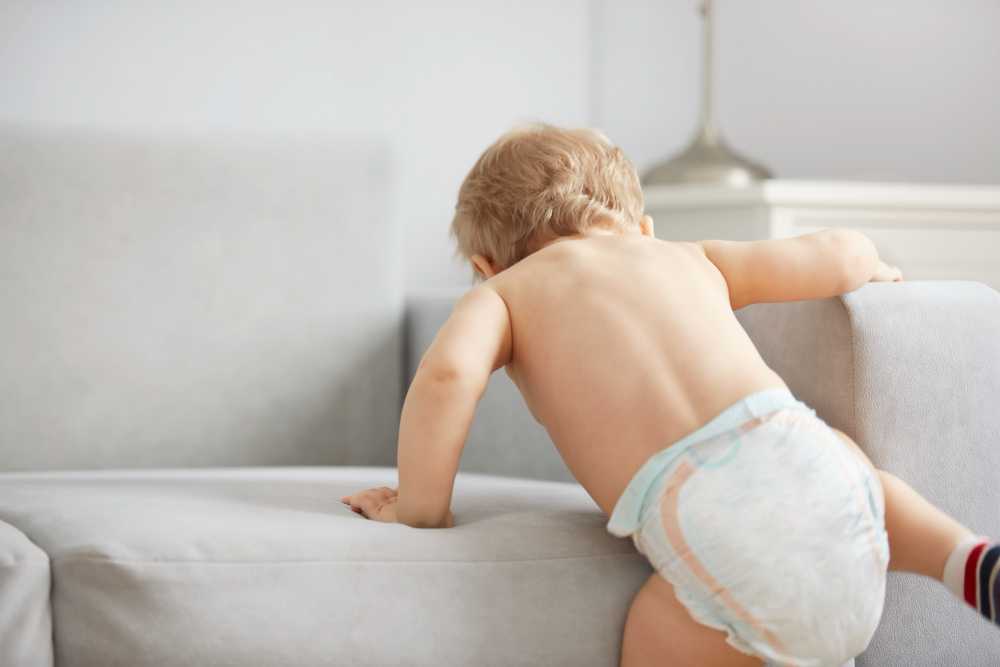The Fan Fascination: Why Babies Like Ceiling Fans

One of the many things that surprise new parents is why babies like ceiling fans. If you are in a room with a fan, you’ll certainly notice that your baby’s eyes are fixated on the moving ceiling fan. This isn’t something you should worry about as it is completely normal and beneficial for your growing baby. If you have a newborn or are watching your young sibling, this article attempts to answer the common question, “Why do babies like ceiling fans?”
Why Do Babies Like Ceiling Fans? 5 Reasons
Babies like staring at ceiling fans for the following reasons:
The Mesmerizing Motion
As mentioned, babies are inherently fascinating and easily get fascinated, even with little things. That said, one of the common reasons babies get drawn to ceiling fans is because of their motion. Ceiling fans rotate in a rhythmic, circular pattern, which creates a mesmerizing visual display for babies.
The circular motion closely resembles the hypnotic dance for babies, which draws their attention. As such, it is not uncommon to find your baby gazing at the ceiling fan’s blades from their crib. The motion of ceiling fans is mostly compared to the increasing popularity of mobiles on baby cribs. Mobiles have toys and rotating shapes dangling above the baby for visual stimulation. Ceiling fans are slow-motion mobiles that provide similar visual engagement.
Auditory Fascination
While the visual aspect can’t be ignored, ceiling fans also provide auditory fascination to babies. Auditory fascination is essentially the baby’s attraction to sound. Ceiling fans produce a soft, humming sound, which captivates the baby’s attention for various reasons and benefits.
For starters, the gentle and rhythmic sound of a ceiling fan is soothing and reassuring to newborns. Ceiling fan motion creates an auditory stimulus that brings forth predictability and an orderly environment. Babies often get comforted by routines and familiar sounds. The soft humming sound of the ceiling fan helps create a calm and peaceful environment.
Secondly, ceiling fans help with auditory tracking. Newborns are curious and naturally inclined to sounds and voices in their surroundings. The soft sound produced by moving ceiling fans allows babies to develop their auditory tracking abilities, which is beneficial for overall sensory and cognitive development. Babies turn and shift their gaze according to the fan’s movement, enhancing their ability to track and locate sounds.
The fan’s auditory stimulation also complements the visual stimulation provided by its mesmerizing motion. This creates a multi-sensory experience, which improves the baby’s sensory development and perception. Simply put, babies are drawn to the soothing and predictable auditory aspects of ceiling fans. The soft sound helps infants explore and learn about their surroundings as they continuously develop their sense of hearing.
A Sense of Comfort
Surprisingly, ceiling fans are a source of comfort for some babies. Ceiling fans move in a gentle motion and produce soothing sounds, which create a calm and secure atmosphere for infants, especially when sleeping. Most parents find that leaving the nursery ceiling fan running helps the baby sleep faster. Babies also sleep soundly.
The combined visual and auditory stimuli that come from the fan are sleep-inducing. Besides, the soft, soothing white noise generated by a running ceiling fan helps mask other in-house sounds that can disturb your sleeping baby.
Contrast and Patterns
Contrast and patterns are the other reasons babies are fascinated by ceiling fans. Ceiling fans are made of distinctive and visually stimulating designs that are highly appealing to babies for the following reasons:
- High-contrast patterns – blades of ceiling fans often feature high-contrast colors and patterns that easily capture your baby’s attention. Babies are naturally attracted to high-contrast images. As such, the bold and distinguishable blades easily stand out against plain ceilings.
- Engagement and distraction – patterned fan blades are a source of engagement and distraction for infants. They gaze at the moving blades, which keep them occupied and soothe them. You can use this to calm them during fussy moments.
- Pattern recognition – babies are inherently drawn to shapes and patterns. The decorative blades of ceiling fans introduce your infant to geometric patterns and designs, which encourage visual exploration and pattern recognition.
- Visual tracking – like auditory tracking, ceiling fans introduce infants to visual tracking. Babies get to enhance their visual tracking abilities by watching running ceiling fans. Tracking the blades’ movement improves their eye coordination and ability to follow objects.
Safe Exploration
Babies are curious by nature. This explains why parents should be cautious with what they leave lurking around their infants. Fortunately, unlike other household items that pose a direct danger to curious babies, ceiling fans are out of reach. This makes them perfect for your baby’s explorative nature.
Babies enjoy observing a moving fan without the risk of getting close or suffering accidental injuries. However, parents should ensure safe exploration by ensuring the ceiling fan is properly installed and doesn’t have loose parts or carelessly hanging cords within the baby’s reach.
Should You Install a Ceiling Fan in the Nursery?
Contrary to what most people, especially new parents, believe, it is perfectly safe to install a ceiling fan in the nursery. You should consider installing it for the following reasons:
Ceiling Fans Lower the Risk of SIDS
SIDS is a nightmare for most parents, especially during the summer months. The risk of SIDS increases significantly during warmer months because babies can’t effectively control their body temperatures. The recommended room temperature for babies during summer should be between 68 and 72 degrees, which their underdeveloped bodies can’t achieve.
A study found that leaving the fan running in the nursery when the baby is asleep reduces the risk of SIDS in infants by 72%. This percentage was higher in warmer rooms than in cold rooms. You can improve your baby’s safety while sleeping by dressing them lightly, placing them to sleep on their backs, and removing toys, blankets, and other items from their crib.
Ventilation and Air Quality
Maintaining good air quality in the nursery is important for your baby’s health and well-being. The quality of air in your nursery affects your baby’s respiratory health, comfort, and sleep patterns. That said, ceiling fans increase ventilation in the nursery by redistributing warm and cold air. Ceiling fans ensure that your baby doesn’t re-breathe exhaled carbon dioxide in the room.
Helps Babies Sleep
The movement of the blades of ceiling fans can lull the baby to sleep. The humming sound has the same calming effect generated by machines designed to produce white noise. White noise helps the baby drift off. It also masks other distractive noises that can wake your baby.
Ceiling Fans are Not Disruptive
Some air conditioners, especially old models, are very loud. Their noise can disrupt your sleeping baby if the unit is kept running to maintain room temperature. On the other hand, ceiling fans are quiet and don’t make noise when running, especially if the speed settings are adjusted properly.
Ceiling Fans are Out of Reach
Freestanding fans always pose a threat to your baby’s safety if left unsupervised. However, this isn’t the case with ceiling fans. Your infant can’t reach the ceiling, even when they grow and become mobile, eliminating the risk of injuring their fingers or messing with its code or power outlet.
Cons of Installing Ceiling Fan in the Nursery
While you should install a ceiling fan in the nursery for the reasons above, you should be wary of the following drawbacks:
Not as Effective as AC in Controlling Room Temperature
Even though ceiling fans are perfect for circulating fresh air in the nursery, they aren’t as perfect as air conditioners in regulating temperatures. AC units can generate and maintain the desired temperatures, while ceiling fans typically move air around the room. They don’t generate cold air.
It Can Trigger Allergies
Sleeping with ceiling fans can trigger allergies in the baby and nursing parents. If you or the baby is allergic, it is best to avoid sleeping with the ceiling fan on. It exacerbates allergic symptoms and other respiratory conditions.
Should You Be Worried if Your Baby is Staring at Ceiling Fans?
You shouldn’t be worried if your baby is staring at a ceiling fan. Most people worry that babies who stare at ceiling fans are autistic, which isn’t entirely true. While gazing at objects is a potential sign of autism, many other factors are involved. An autistic child often has other accompanying symptoms. You should take the baby for a medical checkup if they stare at other inanimate objects or avoid eye contact, mostly after the second birthday.
The Bottom Line
If you are a new parent, you shouldn’t be worried if your baby keeps staring at the ceiling fan. Gazing at ceiling fans is normal for babies and young infants, just like how adults like movies, songs, and dances. However, you should ensure the ceiling fan is perfectly secured and operates safely.





